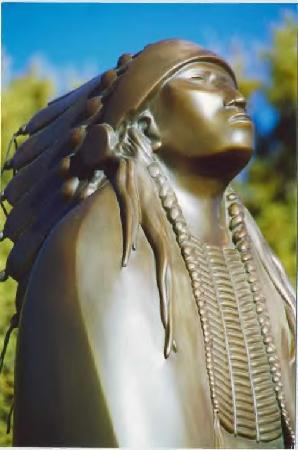|
|
Canku Ota |
|
|
(Many Paths) |
||
|
An Online Newsletter Celebrating Native America |
||
|
September 6, 2003 - Issue 95 |
||
|
|
||
|
License to Teach |
||
|
by Diana Heil The
New Mexican
|
||
|
credits: sculpture
Lament by Allan Houser copyright © 2002 of Suzanne Westerly
|
|
But until Jicarilla Apache President Claudia Vigil-Muniz signed an agreement with the New Mexico Board of Education recently, these two women couldn't enter the public elementary school in Dulce with the right to teach what they know. They don't possess college degrees in education. Thursday, the state Board of Education celebrated the Jicarilla Apache Nation as the first tribe in New Mexico to take advantage of a new teaching certificate that gives Wells and Baltazar license to teach. A 2002 state law allows tribes to determine how they will decide who is competent and proficient enough to teach Native languages in public schools. Thursday, the state Board of Education overwhelmingly approved the rule that sets the Certification in Native Language and Culture (K-12) in motion and gave a final nod to the memorandum of understanding with the Jicarilla Apache Nation. "It does my heart good because we're losing our tribal customs," Irvin Max Phone, one of five Jicarilla Apaches who developed the agreement, said before the state Board of Education on Thursday. Audience and board members gave the Jicarilla Apache Tribe a standing ovation. "We very humbly consider you to be heroes," said board President Adelmo Archuleta, who said that by preserving their language they are preserving the beauty of New Mexico. Already, kindergartners and first-graders in Dulce are benefiting. Wells and Baltazar are co-teachers with Maureen Olson, a teacher with a master's degree in education and an administrator's license. Olson, who narrates a Native language show on Dulce's KCIE-90.5 FM radio station and is working with linguists on a new Jicarilla language dictionary, headed the Jicarilla Language Team that spent a year developing the agreement with the state. Two weeks ago, the trio began its work with children. By talking to one another, students hear the rhythm of the language. "There's little kids who just repeat what you said. Others say, 'Oh, I know what you said!' " Olson said. Twice a week for 30 minutes the teachers bring formal lessons. But for another two days a week, for 45 minutes a day, they assist the regular classroom teacher and speak informally to children in Apache: "Where's your pencil?" "Where's your paper?" "Listen to the teacher." Olson, who ran a language program in the schools for a while, won support for the Native Language and Culture Program through word of mouth. If our kids don't understand Apache, what are they going to be? What if there is no language supporting the culture? "It just seems like the right people were interested. People began to realize that if we don't do something the language is going to be just like something we did long ago," Olson said. "We've had the backing of the Apache legislative council. The majority of them are fluent speakers." Some of the elders hope that when children speak Apache again, they'll gain traditional values such as respect for people, life and ceremonies; a hard-working ethic that starts early in the morning; and a sense of purpose within the extended family. And then there's the simple desire for communication. "I do want my grandchildren hopefully to be able to speak back to me in Apache," Olson said. "That's really the goal." Exchanges aren't the same in the English language. "It's just a different way of thinking," she said. Located in Rio Arriba County, the tribe counts more than 3,000 members. In 1990, Jicarilla Apache speakers numbered 812. "If the real experts of the language are not given the proper status in the classroom, then the children get the impression that their language doesn't have an important place," said Inée Yang Slaughter, executive director of the Indigenous Language Institute. The Santa Fe-based group knows language preservation is a race against time for most tribes and pueblos in New Mexico. In a few New Mexico communities, tribal members of all ages speak the Native language. But in a more common scenario, adults or just grandparents speak and use the language. The children do not. "This really is a wonderful vehicle to accelerate the process," Slaughter said of the certification in Native language and culture. "It also gives the speakers the proper status of teachers in the classroom." The Navajo Nation is working on an agreement with the state, too. But Roz Carroll of the state Department of Education said she's disappointed more tribes aren't pursuing it, given that the idea came from tribal members. |
|
|
||
|
|
||
| Canku Ota is a free Newsletter celebrating Native America, its traditions and accomplishments . We do not provide subscriber or visitor names to anyone. Some articles presented in Canku Ota may contain copyright material. We have received appropriate permissions for republishing any articles. Material appearing here is distributed without profit or monetary gain to those who have expressed an interest. This is in accordance with Title 17 U.S.C. Section 107. | ||
|
Canku Ota is a copyright © 2000, 2001, 2002, 2003 of Vicki Lockard and Paul Barry. |
||
 |
 |
|
|
The "Canku Ota - A Newsletter Celebrating Native America" web site and its design is the |
||
|
Copyright © 1999, 2000, 2001, 2002, 2003 of Paul C. Barry. |
||
|
All Rights Reserved. |
||
 Cleo
Wells and Emelene Baltazar know the nuances of the Jicarilla Apache
language.
Cleo
Wells and Emelene Baltazar know the nuances of the Jicarilla Apache
language.